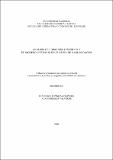| dc.contributor.advisor | Rojas González, Margarita | |
| dc.contributor.author | Espinoza Céspedes, Francisco | |
| dc.contributor.author | Morales Valverde, Allan | |
| dc.date.accessioned | 2020-08-25T18:19:37Z | |
| dc.date.available | 2020-08-25T18:19:37Z | |
| dc.date.issued | 2008 | |
| dc.identifier.other | 000098857 | |
| dc.identifier.uri | http://hdl.handle.net/11056/17983 | |
| dc.description.abstract | El primer capítulo de la investigación presenta particularidades del romanticismo y del modernismo, debido principalmente a dos aspectos: según el crítico Varela Jácome, la novela histórica tiene amplia relación con el romanticismo. Por ello, es necesario examinar las características de la novela histórica para determinar si éstas se encuentran en el texto de Gagini. Relacionado con esto, la fecha de publicación de El Erizo corresponde a una época muy posterior al romanticismo. Ahora bien, se ha considerado el año 1916 como la fecha que marca el inicio de la declinación del modernismo. Hay que tomar en cuenta que en Costa Rica este declive se presentará posteriormente; por lo tanto, es posible argumentar que para 1922, según Cedomil Goiç, la corriente literaria presente en el país era el modernismo. Por ende, se hace necesario también explorar este movimiento para comprobar su presencia en el texto de Gagini.
En el segundo capítulo se presentará una síntesis de los acontecimientos y se realizará un amplio análisis del texto, así como de sus componentes y características.
En el tercer capítulo se analizará la estructura del relato para determinar sus características y su influencia en los roles que cumple cada personaje, así como la relación de los tópicos universales del doble y la metamorfosis.
El cuarto capítulo muestra una serie de comparaciones de la obra de Gagini con otros textos que se refieren de alguna manera a la Campaña Nacional o a Juan Santamaría. Esta comparación tiene como principal objetivo valorar los diferentes enfoques que diversos autores costarricenses le han dado a la figura del héroe nacional.
Finalmente, hay un apéndice donde se presentan algunos documentos históricos relacionados con la Campaña Nacional y con la figura del héroe. | es_ES |
| dc.description.abstract | The first chapter of the research presents particularities of romanticism and modernism, mainly due to two aspects: according to the critic Varela Jácome, the historical novel has a wide relationship with romanticism. Therefore, it is necessary to examine the characteristics of the historical novel to determine if they are found in Gagini's text. Related to this, the date of publication of El Erizo corresponds to a period much later than Romanticism. However, the year 1916 has been considered as the date that marks the beginning of the decline of modernism. It should be taken into account that in Costa Rica this decline would occur later; therefore, it is possible to argue that by 1922, according to Cedomil Goiç, the literary current present in the country was modernism. Therefore, it is also necessary to explore this movement to verify its presence in Gagini's text.
The second chapter will present a synthesis of the events and will make a broad analysis of the text, as well as its components and characteristics.
In the third chapter, the structure of the story will be analyzed to determine its characteristics and its influence on the roles played by each character, as well as the relationship of the universal topics of the double and the metamorphosis.
The fourth chapter shows a series of comparisons of Gagini's work with other texts that somehow refer to the National Campaign or to Juan Santamaría. The main objective of this comparison is to evaluate the different approaches that various Costa Rican authors have given to the figure of the national hero.
Finally, there is an appendix where some historical documents related to the National Campaign and the figure of the hero are presented. | es_ES |
| dc.description.sponsorship | Universidad Nacional, Costa Rica | es_ES |
| dc.language.iso | spa | es_ES |
| dc.publisher | Universidad Nacional, Costa Rica | es_ES |
| dc.rights | Acceso abierto | es_ES |
| dc.rights | Attribution-NonCommercial-NoDerivatives 4.0 Internacional | * |
| dc.rights.uri | http://creativecommons.org/licenses/by-nc-nd/4.0/ | * |
| dc.subject | GAGINI CHAVARRIA, CARLOS, 1865-1925 | es_ES |
| dc.subject | LITERATURA COSTARRICENSE | es_ES |
| dc.subject | NOVELA COSTARRICENSE | es_ES |
| dc.subject | ANÁLISIS LITERARIO | es_ES |
| dc.subject | COSTA RICAN LITERATURE | es_ES |
| dc.subject | COSTA RICAN NOVEL | es_ES |
| dc.subject | LITERARY ANALYSIS | es_ES |
| dc.title | Análisis del discurso histórico y el modelo literario en el erizo de Carlos Gagini | es_ES |
| dc.type | http://purl.org/coar/resource_type/c_7a1f | es_ES |
| una.tesis.numero | 6313 | es_ES |
| dc.description.procedence | Escuela de Literatura y Ciencias del Lenguaje | es_ES |


